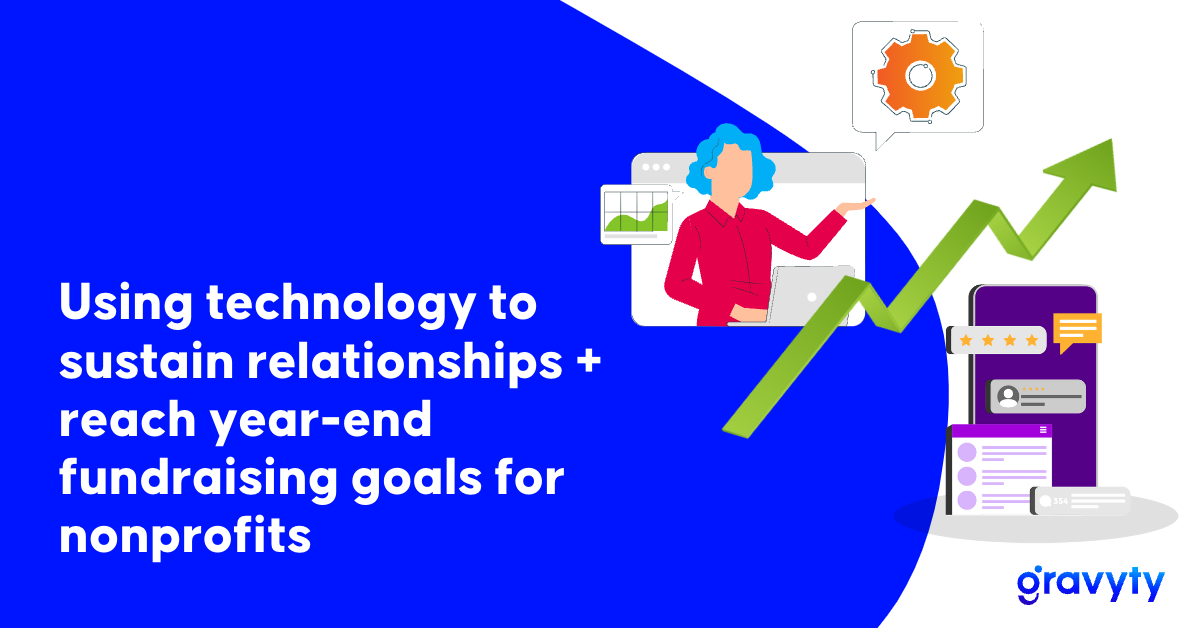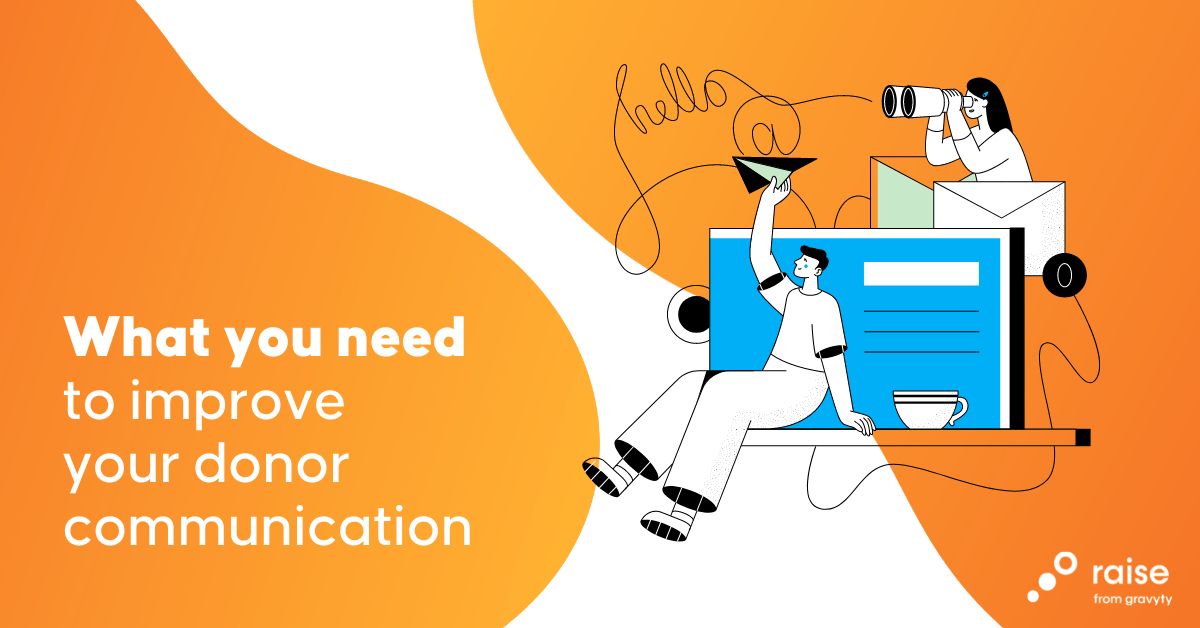11 top fundraising trends [Updated 2024]

In the past few years, fundraising organizations have seen an incredible influx of new donors wanting to contribute to their causes. According to Giving USA’s 2023 annual report, an estimated $499.33 billion was donated to US charities in 2022—a 3.4% percent decrease year over year. And it’s no surprise—recent years have brought hardships and uncertainties for many, including an economic downturn and global inflation. But what’s in store for the next year?
While many nonprofits and other fundraising organizations have begun to recover since the pandemic, the world is preparing for another tumultuous year. Rising inflation and interest rates, sky-rocketing fuel costs and a worldwide cost of living crisis will all have an impact on nonprofits’ ability to raise funds.
To launch strong into 2024, nonprofits and educational institutions must face the coming year’s challenges head-on and learn the strategies and behaviors that will allow them to cultivate strong donor relationships, retain existing donors and attract new donors—even (and maybe especially) under difficult circumstances.
Explore these fundraising trends to help shape fundraising strategies in the coming years.
Fundraising trend #1: Personalized outreach is no longer a nice-to-have
No donor likes a generic thank-you email, or worse, a bland and impersonal request for a donation. Fundraisers have increasingly understood this and have taken great strides to make sure that their teams are equipped with the right information needed to make all their donor communications personal and meaningful.
In practice, this means not only maintaining an up-to-date and relevant donor database but also using the information it contains to extract those relevant details and create personalized communication and requests. With more and more people tightening their belts in these precarious times, personalized outreach is more important than ever before, but it is also one of the most time-consuming and difficult jobs on a fundraiser’s plate. Fortunately, AI-powered fundraising software can alleviate some of these pressures by cutting out much of the grunt work involved in personalized outreach.
Fundraising trend #2: A donor retention strategy is critical for ongoing growth
Donor retention will be critical to keeping cash flow strong this year. It is easier and cheaper to build on past successes by maintaining good relationships with existing donors than to keep launching entirely new campaigns. Existing donors are already familiar with your organization and have been attracted to your message in the past. Research corroborates this, showing that the retention rate for first-time donors is just 20%, while repeat donors are 60% more likely to stick around for the longer term.
To succeed at donor retention, you need a strategy as well as a way to measure your success. Tracking donor retention will allow you to identify how well you are succeeding in this important activity, identify any lulls in donations, and make necessary adjustments to restore giving to its former levels. AI-based fundraising tools can help you track this all-important information.
Fundraising trend #3: Reclaim available dollars with donor advised funds payment acceptance
Donor advised funds (DAFs) are the fastest growing vehicle in philanthropy. The number of DAF accounts has nearly tripled over the last four years, and they make up 17% of annual giving in the United States as of 2022 (up from 7% just five years ago). With $230 billion sitting in DAF accounts ready to be donated, fundraising organizations need to adapt strategies now in order to benefit from this lucrative giving vehicle for years to come.
Concerningly, though, many fundraising organizations are behind in offering this payment option. A study conducted by Gravyty to measure effectiveness of 2023 GivingTuesday campaigns found that none of the organizations that were a part of the study offered DAFs as an option on their giving form. To capitalize on DAF donors, organizations should offer a DAF payment option on their online giving sites for seamless, digital giving. Gravyty’s digital fundraising platform integrates with Chariot, a technology provider that offers Donor Advised Fund payment option on digital giving forms.
Fundraising trend #4: Reach donors where they are with peer-to-peer texting
With the oversaturation of voice channels for commercial outreach and ‘robocalls’, a trend is emerging: the new generations of donors prefer to interact on digital and mobile channels.
Texting as a key method of communication for generations of donors is clear, with 75% of Gen Z and Millennials saying they would rather text than talk on the phone, and over a third of Boomers saying it’s acceptable for brands to text them a few times a week. What’s even more exciting for fundraisers is donors’ affinity for mobile giving: 76% of Gen Z donors give online.
So what does this rise in text as the preferred communication channel mean for fundraising organizations? Peer-to-peer (P2P) texting is easy to implement and quick to deliver results. P2P offers an authentic and scalable way to connect with donors personally, making them feel more connected to your organization and likely to become long-term supporters.
Fundraising trend #5: In-person events are back
Since the post-pandemic return to reality, people have been enjoying real-life events where they can once again meet and mingle in the flesh. That said, the behavioral changes triggered by the pandemic are certainly lingering.
Over the last few years, most people have been forced to communicate, work, and socialize almost exclusively online, and have begun to appreciate the speed, ease, and conveniences of online events.
Now, the best approach will be to cover all bases. Offer a range of online and in-person events to make sure you cater to every taste. To boost engagement of your new and improved in-person events, reach your donor base in a personal and meaningful way. Your donors are flooded every day with solicitations to donate and participate in organizations’ missions; make your organization stand out with custom and personal messages made specifically for them. A personalized video messaging tool can help you steward, invite and thank donors when it matters most.
Online fundraising events like giving days that allow for real-time chat and fast online donations may be particularly attractive to Gen Z and younger millennials and is a highly effective way for you to boost and scale donations. A giving day platform allows organizations to create fully branded, gamified giving experiences for their donors to keep them engaged and inspired to participate.
Fundraising trend #6: Trust-based fundraising is in
During challenging times, people are naturally more risk-averse. To retain donors and attract new ones this year, it’s important to focus intensely on building trust with your donors and constituents. The core of trust-based philanthropy is relationship building. Just like with any other relationship, nonprofits, educational institutions and other fundraising organizations will have to work hard at open and honest communication, listening and learning about their donors, and being responsive at all times. It is also particularly important to be transparent about your use of funds and to be ready to promptly share any information that donors ask for.
Fundraising software will help staff keep up with many of the actions that help build trust including thanking donors within 72 hours of each donation, sharing impact stories, asking donors for feedback and remembering donors’ birthdays and anniversaries.
Fundraising trend #7: Fundraising technology will ease staffing and resource challenges
Like many fundraising organizations today, you might be making the most of the small but dedicated staff you currently have. While your team members are likely to be stressed and time-crunched under these trying conditions, there are tools that fundraisers are leaning on to alleviate some of the resource strain.
AI-powered fundraising tools can cut out some of the most laborious donor cultivation activities enabling them to achieve so much more with their time. For example, use AI to scour your CRM to identify who to approach, when, and with what messaging.
You can also lean on AI technology to draft outreach emails complete with personal details. These functions can cut hours of research time out of a fundraiser’s day and enable them to cultivate more donor relationships in the same amount of time.
Fundraising trend #8: Improve community connection with your cause
Building and maintaining community is something that is steadily growing in importance in the nonprofit world. As much as your donors support you, you need to support your donors and make sure they feel good about giving to your organization.
To survive and thrive in the modern era, organizations must be engaged in and relevant to the community they seek to serve. This means getting out and communicating with community members and finding out what it is they value.
Running both online and in-person events will allow you to meet your people and build deeper connections. Questionnaires and surveys can also help you gain a better appreciation of who your community is and what makes them tick.
Most importantly, communicate regularly and meaningfully with your community. Send out frequent digests, newsletters and reports about your activities so you remain at the forefront of their minds. Personalized and targeted communications are more effective than generic mass-produced ones.
Fundraising trend #8: Flexible giving and participation options will be the new norm
If one word can be used to define what will help organizations thrive these days, it is “flexibility.” Nonprofits, schools and other organizations need to be inventive and find new and diverse ways to raise funds instead of relying on traditional methods that may no longer be effective.
We’ve already discussed this in the context of planning a range of online and in-person events. Creativity must also be applied when deciding on the types of events to offer. Think about what your audience needs today and dream up new offerings to try and keep them engaged.
Another area in which flexibility is critical is payment options. These days, a staggering 63% of people prefer to give online (versus other methods like direct mail, wire transfer, and cash).
The key is to make it easy for donors to donate in a range of ways especially via mobile devices. Offer a wide range of payment methods, including those from digital wallets, peer-to-peer and online transaction portals (such as PayPal, Apple Pay, Google Pay, Venmo, and Facebook).
Fundraising trend #10: Take donor stewardship seriously
A recent report from Chronicle of Philanthropy suggests that the number of small gift donors fell significantly in the first half of 2022 as compared to the previous year.
Small donors may not make as much of an impact individually as big-ticket donors, but every fundraising organization knows how much their impact adds up over time—especially if they give repeatedly.
It’s important to appreciate that small donors are likely to be the worst affected by the current economic turmoil. This means they will think more carefully about every penny they donate.
This makes stewardship all the more important. Keep the lines of communication open throughout the year and not just at campaign times to make sure your smaller donors still feel involved and appreciated, even if they can’t give at this time. Eventually, things will pick up, and they will make a gift in the future if they feel connected to your organization during each phase of life.
Fundraising trend #11: The donor pipeline depends on finding new donors and increasing donor participation
Despite your best donor cultivation efforts, some will inevitably fall by the wayside. It may be because their priorities have changed or due to financial challenges. Either way, you will want to lessen the impact of these losses as much as you can. This means remaining mindful of where your next donor is coming from at all times and actively planning how to onboard new donors.
As well as working to grow your donor pipeline, you also need to keep existing donors engaged and interested. Knowing as much as possible about your donors can help you do this effectively. AI fundraising software can help you identify new donors as well as decide when it’s time to reach out to existing donors. It can also help you decide exactly how to reach out and what to say—whether it be a request for a donation, a simple activity report or a birthday greeting.
Be flexible and thrive
This year will be characterized by flexibility. In tumultuous times it’s important to be as adaptable as possible and nonprofits that move with the times will be able to cultivate existing relationships and build new ones effectively. Fundraising technology will be key to helping alleviate many of the burdens fundraisers face in building meaningful relationships with donors.
Learn how Gravyty can help you cultivate, retain and steward your donors easier, faster and more efficiently so your organization can thrive in the modern era. Let’s talk.



